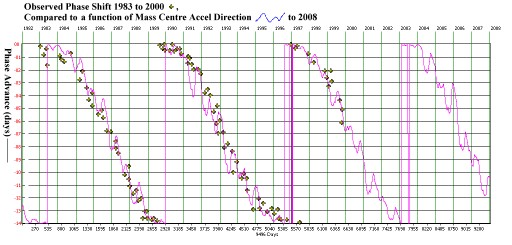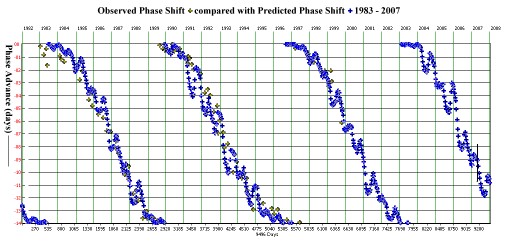
|
The
Phase Shift
To be developed further. |
 |
Over the years, "Bud Events" (λ Dips, or Peaks) have slipped in time fairly steadily ahead of the alignments to which, by their matching rhythms, they very clearly correspond. In due time (7 years) they slide from synchrony through a state of syncopation ("on the off-beat"; about 7 days out; exactly half way) into synchrony once more. |
| Lawrence Edward's phase shift observations are shown above (yellow crosses). He said that, "Each [cross] represents the phase shift of a species for a season." So each cross is supported by hundreds - in some instances, by thousands - of measurements. |
|
A model
- or hypothesis, if you prefer - of this behaviour has been developed,
which fits past observation well enough to permit prediction of future
phase-shift behaviour. Shorn of detail, the hypothesis says that the buds
move to a Time that runs ahead of ordinary Time - that is to say, ahead of the Time shown on our clocks and by which we miss trains. |
 |
Specifically, "Now"
generally comes sooner (by our watches) for the buds. Direction of the state of motion of the aggregate mass of the bodies of the Solar System, and the Direction of their aggregate position, both relative to the Sun. |
Suppose there is an alignment of the Moon with, say, Saturn, on, say, the 1st of June by what I shall call the Ordinary Calendar, and that the 1st of June is today's date. By the "Bud Calendar", the 1st of June, and its corresponding alignment, may have come and gone, let us say 3 days before today - this interval being reckoned as the time that has elapsed between the bud event and the alignment, as observed and timed by users of the ordinary calendar. |
| The graph above right shows both the match to observations from 1983 and the predictions until 2008. The prediction for December 2006, and January, February and March of 2007, is that Bud Events should be running, on the average, just over 9 days ahead of their alignments. Observation tends to support this. |